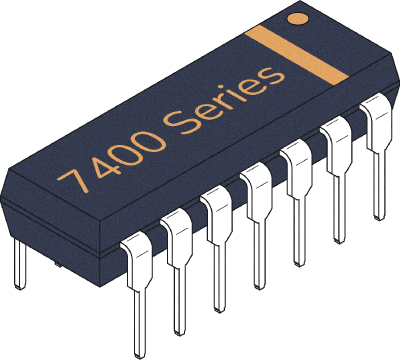The 74×164 (ex 74HC164) is a chip that includes an 8-bit serial-in, parallel-out shift register.
In this guide, you’ll learn the things you need to know about this chip in order to use shift registers in your own projects.
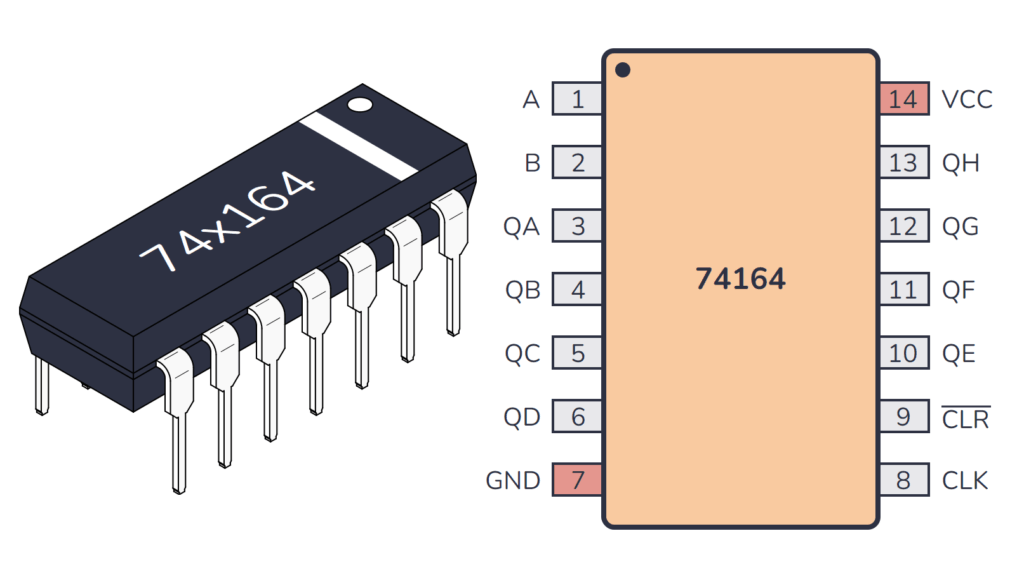
What does the 74HC164 / 74LS164 do?
The 74×164 is an 8-bit serial-in, parallel-out shift register. This means it takes in data one bit at a time through a serial input, and then after each clock pulse, shifts the data along, eventually outputting all 8 bits of data in parallel.
If you’re not familiar with shift registers, I recommend checking out our Beginner’s Guide to the Shift Register.
Here’s how it works:
- You input data one bit at a time through either of the two serial data inputs (A or B).
- Each time a clock pulse is received, the data shifts along the register.
- Once all bits are entered, you can access the stored data via its 8 parallel outputs (Q0 to Q7).
This chip is great for expanding the number of output lines in a microcontroller project or for serial-to-parallel data conversion.
Why Two Inputs?
The chip has two data input pins, called A and B.
These inputs work together using an AND gate, which means both A and B need to be “on” (or high) for the data to go in. If either A or B is “off” (or low), the data won’t get in.
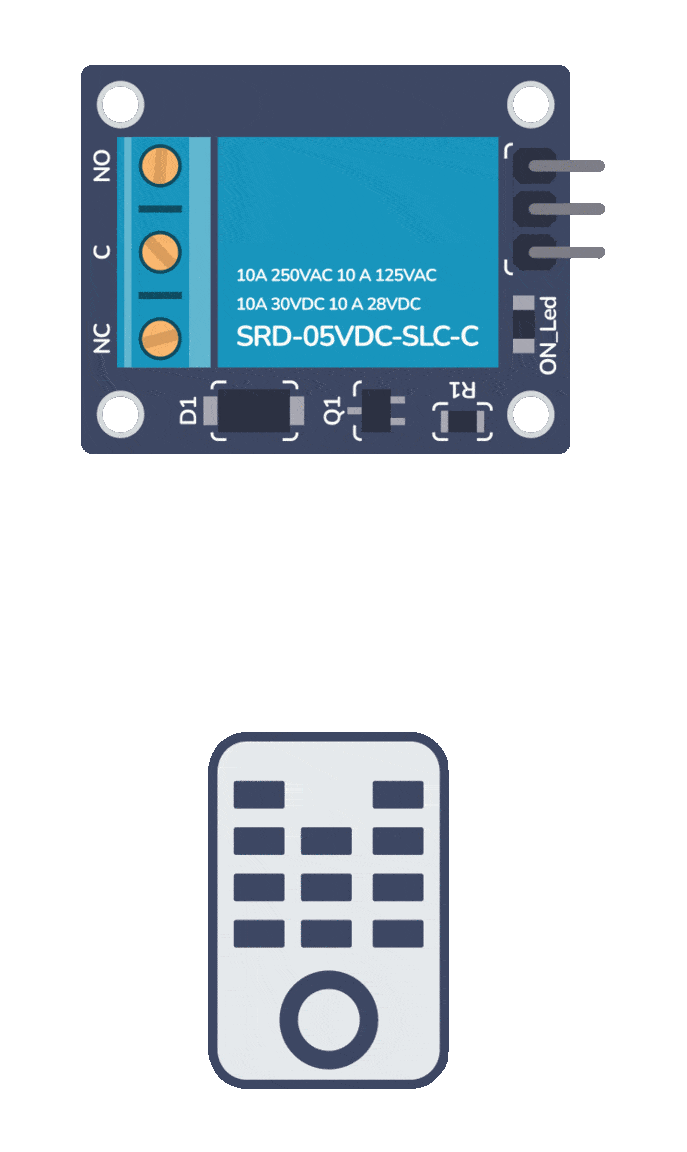
Build Something Useful This Evening
This gadget lets you use any IR remote-control to control your lamp, garden lights, heater oven, garage door, or anything else.
Having two inputs can be beneficial in some cases:
- Extra Control: You can control the data better because both inputs need to agree (both high) to let the data in.
- Reducing Errors: It helps prevent accidental data entry due to electrical noise or spikes making sure both inputs confirm the data.
- Flexible Setup: You can wire A and B to different signals, allowing more control over when and how data is allowed in.
So, the two inputs give you better handling and flexibility with the data moving into the 74LS164.
How To Use This Chip
The 74HC164 comes in a 14-pin package, and you need to connect it to power before you can use it. Most 7400 ICs support a VCC voltage of 5V. One difference between the HC and LS version of the chip is that the 74HC164 supports 2V to 6V, while the 74LS164 only supports 5V.
74HC chips can normally supply a maximum of 4 mA from an output pin. If you’re using the 74LS version, the maximum current you can pull out of one output pin is 0.8 mA when the pin is high (sourcing) or 16 mA when the pin is low (sinking).
But these values can differ between models, so check the datasheet of your model to verify.
Once you’ve connected it to power, you can use the Shift register inside.
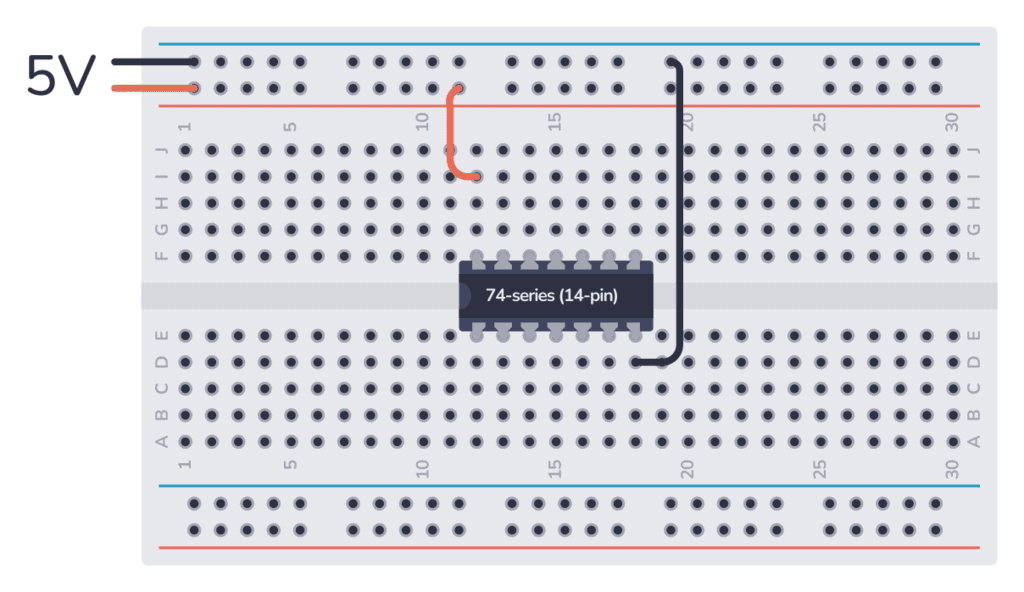
If you want to use it as a normal shift register, set the B input high, and use the A input for your data (or vice versa). For every time the CLK signal goes high, the data on the A input is shifted into the shift register.
74×164 Pinout
The 74×164 has 14 pins and contains 8-bit serial-in, parallel-out shift register laid out as shown in the pinout diagram below:
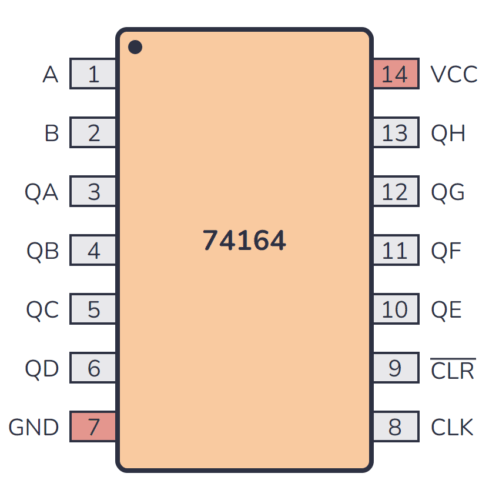
| Pin Name | Pin # | Type | Description |
|---|---|---|---|
| A | 1 | Input | Serial data input A for the shift register. |
| B | 2 | Input | Serial data input B for the shift register. |
| QA | 3 | Output | Output from the first stage of the shift register. |
| QB | 4 | Output | Output from the second stage of the shift register. |
| QC | 5 | Output | Output from the third stage of the shift register. |
| QD | 6 | Output | Output from the fourth stage of the shift register. |
| GND | 7 | Power | Connect to ground (GND). |
| CLK | 8 | Input | Clock input for the shift register. |
| CLR | 9 | Input | Asynchronous clear input for resetting the shift register (active low). |
| QE | 10 | Output | Output from the fifth stage of the shift register. |
| QF | 11 | Output | Output from the sixth stage of the shift register. |
| QG | 12 | Output | Output from the seventh stage of the shift register. |
| QH | 13 | Output | Output from the eighth stage of the shift register. |
| VCC | 14 | Power | Positive power supply. Connect to +5V power. |
Alternatives and Equivalents for 74HC164 / 74LS164
There are many versions of the 74×164 chip. They all have the same functionality, but with different specifications such as supported voltages and maximum current output.
Here’s a list of a few equivalents of this chip:
- 74HC164 (High-speed CMOS)
- 74HCT164 (High-speed CMOS, TTL compatible)
- 74LS164 (High-speed TTL)
- 74LVC164 (Low Voltage TTL)
- 74AC164 (Advanced CMOS)
- 74ALS164 (Advanced Low-Power Schottky TTL)
- 74F164 (Very High Speed)
- 74C164 (CMOS, similar to the 4000-series)
Some manufacturers also add a prefix, such as the SN74HC164 and SN74LS164 by Texas Instruments.
Can’t find the 74×164 anywhere? Then try one of the following IC alternatives:
- 74×91 – 8-bit shift register.
- 74×95 – 4-bit shift register, parallel in, parallel out, serial input.
- 74×166 – Parallel-load 8-bit shift register.
- 74×595 – 8-bit shift register with output latches.
- CD4014 – 8-bit parallel-in, serial-out shift register.
- CD4015 – Two 4-bit serial-in, parallel-out shift registers.
- CD4021 – 8-bit parallel-in, serial-out shift register.
- CD4094 – 8-bit shift register with latch outputs.
If you can’t find the 74×164 IC in your local electronics store, don’t worry, you’ll most likely find it in one of the stores listed on this page of online stores where you’ll find components and tools for all your electronics projects.
Datasheet for the 74LS164 and 74HC164 chips
Download the PDF datasheet for your version of the 74×164 here:
- SN74HC164 (Texas Instruments)
- SN74LS164 (Texas Instruments)
- 74HC164 (Futurlec)
- 74LS164 (Futurlec)
- 74HC164 (Diodes Inc)
- 74HC164 (Nexperia)

Build Something Useful This Evening
This gadget lets you use any IR remote-control to control your lamp, garden lights, heater oven, garage door, or anything else.

